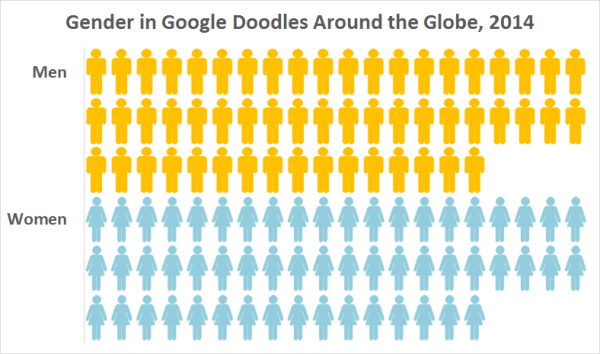Now that 2014 is (well!) behind us, I’ve had a chance to look back on the year. And I must say, Google was able to deliver on the early promise of 2014, when the first 3 Doodles of the year all honored women (Zora Neale Hurston, Dian Fossey, and Harriet Tubman). I hope that the Doodles team is able to continue this effort to be more mindful and conscious in their approach to selecting honorees.
Click below the fold, and let’s take a look at the gender breakdown of Doodles throughout 2014, isolating Doodles shown in the US (where I live) and also considering all the Doodles shown around the world.
(For more information on my methodology and approach to counting male and female individuals honored with a Doodle, check out this post from summer 2012. There is one significant update: this year, there were some Doodles that were shown in most countries except in the United States. Google’s “Doodle Finder” service has recently started categorizing some of those Doodles as “Global” and has made some other changes to how Doodle country stats are displayed. These changes add a complication to my tracking. I’ve tried to carefully keep track, but it’s possible I’ve made a mistake or two! Contact me if you are interested in the dataset that I use to build this site’s gender statistics.)
First, we’ll look at the gender distribution of all Doodles posted in 2014, anywhere around the world — which turns out, this time around, to be an even 50/50! Or, more accurately, an even 56/56. There were fewer total Doodles than in the past (in 2013, there were 155 total Doodles, and only 112 this time) but more women were selected and included.
This is a pretty stark improvement in a very short period of time. I have to think that 50% representation was a concrete goal, or even a challenge, for the Doodles team to meet. Looking at this same information graphically, the stark reality of even representation jumps out immediately. This view is quite a bit different from what I’ve had to post in the past:

The situation in the US is quite similar, though the total number of Doodles is of course significantly smaller and the representation of women is even better!
 In 2013, 20 men were honored with Doodles, compared to 12 women. If you put the two years together, 27 men and 24 women have been honored with a Google Doodle, so that’s pretty close to the 50/50 noted internationally in 2014 alone. I love that women saw slightly more than 50% representation this year, perhaps (or unintentionally) as a corrective factor for the embarrassing Doodles past.
In 2013, 20 men were honored with Doodles, compared to 12 women. If you put the two years together, 27 men and 24 women have been honored with a Google Doodle, so that’s pretty close to the 50/50 noted internationally in 2014 alone. I love that women saw slightly more than 50% representation this year, perhaps (or unintentionally) as a corrective factor for the embarrassing Doodles past.
Has Google shown themselves to be on the right track? Absolutely, and I applaud these efforts. I hope that diversity in all dimensions continues to be an objective that they pursue explicitly, mindfully, and with purpose going forward.


I’m happy about more diversity in the doodles — the Veteran’s Day doodle inspired me too look up the very interesting real stats on the ethnic and gender makeup of the US armed forces, something I hadn’t thought about in years — but why are they so relentlessly ugly? There for a while, they were pretty, then they were rather pretty and quite ingenious, then just ingenious, and lately they’re just plain graphically weak, poorly drawn, watery, and… pretentious corporate fake naivete? they’re well past the ‘so ugly, it’s cute’ line and are on ‘so ugly, it’s ugly’ turf. I’m sure google could acquire designs from among all the best graphic artists in the world, so…? Who on earth is selecting these things? Maybe it’s someone who always wanted to learn to draw but never did and is angry about it. The new logo is also simply weaker, graphically.
By the way — as of 2010, 31% of women in the armed forces are African American (as of 2010) while 6% of the US population is in that demographic.
Sorry, that was poorly edited; I don’t have my glasses and it can’t be corrected once it’s posted, so watch out : )